9v9 Soccer Formations (8 Great Options to Choose From)
Representing a key stage on the journey to playing 11v11 soccer, 9v9 is when youth players really start to understand positioning, tactics, and formations.
Usually played by 11 to 13-year-olds, 9v9 soccer allows players to hone their touch and technique before they progress to playing on a full-sized pitch.
At this age, they should also begin to grasp what positions to take up on the pitch, how to create space and time for themselves, and how to work alongside their teammates.
Naturally, formations play a crucial role in the players' development by allowing them to thrive, learn new skills, and improve their tactical knowledge.
Let's first take a look at some things to take into account when selecting a line up before looking at the best and most common 9v9 soccer formations and the pros and cons of each of them.

What to Take into Consideration When Choosing a Formation and Line Up
As everyone knows, there’s not one formation that suits every team all the time as the success of your line up and tactics depends on a number of factors.
Formations are important for giving a team structure and shape, so it’s a good idea to think long and hard about which set up would best suit your players.
Before going into the pros and cons of each of the 9v9 soccer formation, here are some things to take into consideration when choosing your line-up, whatever the occasion or age group:
1. The Players
While you may want to play a very attacking, possession-based style of play, it’s very hard to do so if you just don't have the players for it.
As such, your formation and tactics really depend on the players you have available to you.
Playing to their strengths will not only go a long way to helping the team perform well, but will also help them enjoy their soccer more.
2. Balance and Shape
When selecting a formation you also want to think about the balance and shape of the team.
While this could mean not opting for a super attacking line up or a formation that leaves your flanks exposed, it can also mean protecting weaker players by selecting stronger players alongside them.
This helps the team retain its shape and balance and doesn't leave gaps or weaknesses for your opponents to exploit.
3. Your Opponents
Another important factor to take into consideration when selecting your line up and formation is the opposition you’ll be facing.
While you don't want to completely change your team's style of play and soccer coaching philosophy, it’s sometimes necessary to be pragmatic and tailor your tactics to your opponent.
Facing different teams and playing styles is obviously a key component of soccer, so it’s always worth introducing your team to different tactics and ways to counteract opponents.
4. Experiment
Having said that, you don't want to surprise your team on the day of a match with a new formation and line up.
Instead, use training sessions to experiment and try out various systems and approaches.
While this will help your players learn more about soccer tactics and formations as well as improve their positioning, a different set up may help other players thrive and showcase their talents.
5. Include and Use Everybody
On that note, it’s crucial to highlight the importance of using all your players and giving them equal opportunities and minutes.
Youth soccer is all about helping players to develop and flourish and enjoy playing the beautiful game.
This means including everybody, creating a positive team environment, and not simply trying to win every single match you play.
As you can see, there really are a lot of different factors to take into account when selecting your formation and line up.
It really depends on the players you have at your disposal, the opponents you’re facing, and what learning points you'd like to get across.
With that in mind, let's now take a look at the best and most common 9v9 soccer formations.
The Best 9v9 Soccer Formations
As with 7v7 formations, 8v8 formations, and full-sized 11v11 formations, there are many 9v9 formations out there for coaches to choose from.
While each line up has strong and weak points to them, these can both be accentuated or diminished depending on the instructions you give your team and the personnel you select.
Besides taking into account the opposition you’re facing, it’s important to choose a formation that gets the best out of your players and helps the team retain its structure and balance.
Whether you’re looking to attack, defend, or control possession, these are the best and most commonly used 9v9 soccer formations:
3-2-3 Formation
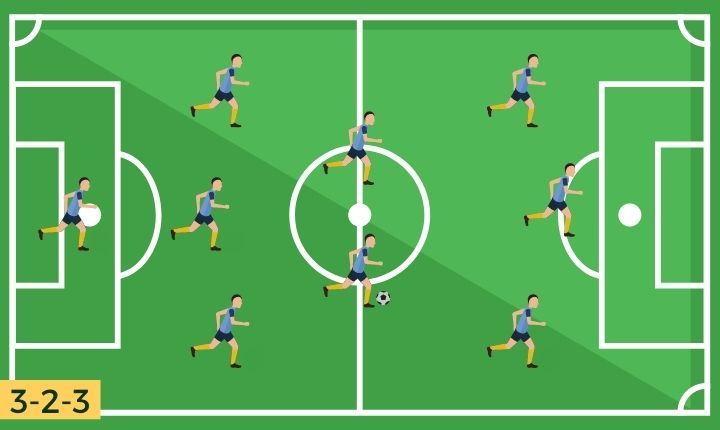
Possibly the most commonly used formation out there, the 3-2-3 is very balanced as it has width out wide, numbers up front, and strength at the back.
As the players are spread all over the pitch, lots of space, depth and passing angles are created which allow teams to control possession and dictate play.
While the formation is quite easy to explain, it relies on the wide forwards tracking back and supporting the central midfielders so that they don't get overwhelmed or outnumbered.
Pros:
- With players spread all over the pitch, the formation is very balanced and structured.
- While it’s solid at the back, it also offers up lots of attacking opportunities.
- With this formation, teams can control possession due to all of the passing angles it creates.
Cons:
- The central midfield pairing can get overwhelmed if the wide forwards don't track back or help out.
- The wide forwards need to be disciplined, hard-working, and have great stamina.
- The opposition has space and time to attack from out wide if the team doesn't drop back and defend all together.
3-3-2 Formation
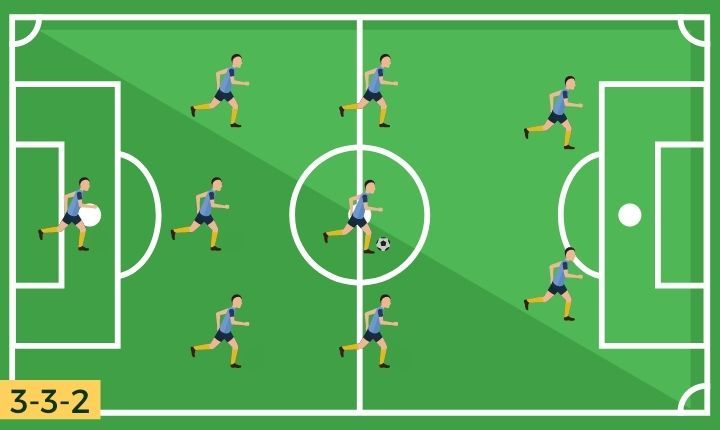
Another very common 9v9 formation is the 3-3-2 which is very solid and hard to play against.
With three defenders and three midfielders in front of them, the opposition should struggle to score while the two strikers up front mean that the team still offers up a goalscoring threat.
As the forwards will often be outnumbered, the 3-3-2 relies on the midfielders pushing forward and joining in the attack before dropping back into position when the ball is lost.
Pros:
- While it’s compact and hard to play against, the 3-3-2 stills offers up an attacking threat through the two strikers.
- With players spread out around the pitch, it should be quite simple for the team to dominate possession.
- As the formation is quite simple to explain, players should have no problem understanding what’s required of them.
Cons:
- The forwards have to be quite imaginative and creative in terms of the runs they make and the spaces they take up if they’re to threaten the opposition.
- As the midfielders are required to both defend and attack, they can leave gaps in behind for the opposition to exploit.
- Due to the fact that the formation is very structured and balanced, players don't have all that much freedom to express themselves.
3-1-3-1 Formation
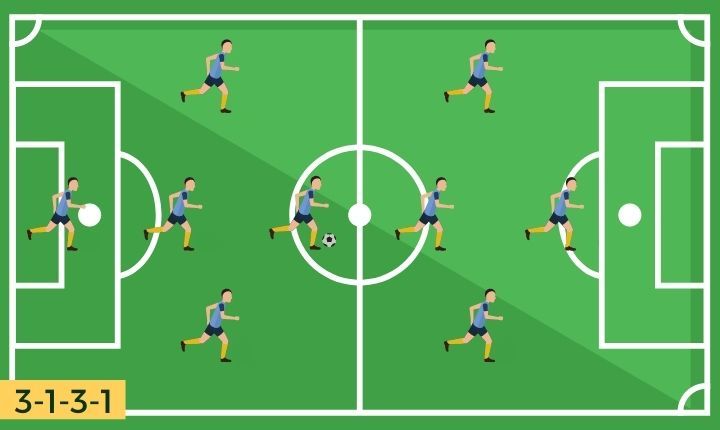
A formation that allows for much more creative freedom, the 3-1-3-1 has a specialised defensive midfielder which allows the forward players to attack with aplomb.
While this can lead to lots of interesting passing combinations and lots of goalscoring opportunities, the wingers and attacking midfielder still need to be disciplined, hard-working, and help out in defence.
Just as crucial to this formation is the defensive midfielder who must have great positioning, be good at tackling, and calm and collected on the ball.
While the 3-1-3-1 can dominate possession and get teams scoring loads of goals, it isn't necessarily weak at the back although this depends on if the forwards track back or not.
Pros:
- The formation allows you to select lots of creative, attacking players.
- Teams using the 3-1-3-1 can dominate possession and score lots of goals.
- The defensive midfielder buzzing about in front of the three defenders means the team shouldn't concede too many goals.
Cons:
- To play this formation, you really need a specialised holding player as well as numerous flair players who are good in possession and don't mind tracking back.
- The opposition can exploit the spaces directly in front of each fullback.
- The defensive midfielder can get overrun and outnumbered if the others don't help out.
3-4-1 Formation
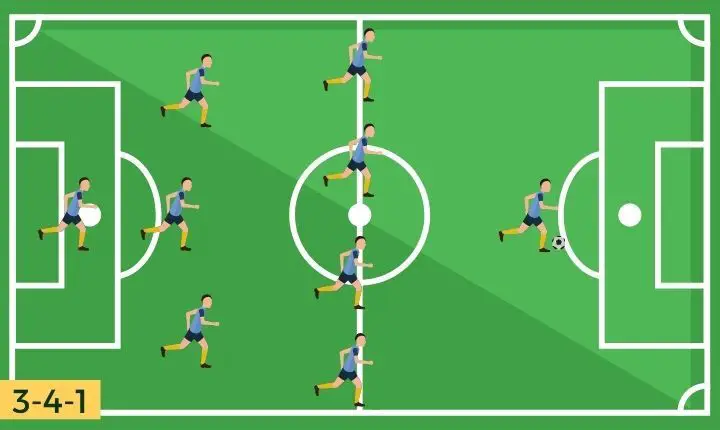
A more defensive and easier-to-explain version of this formation is the 3-4-1 which gives players less freedom but more stability and structure.
Instead of a specialised holding, the team has two central midfielders who can both protect the defence and attack from time to time.
On either side of them are two wide midfielders who are expected to stay out wide, give the team width, and push forward to help out the lone striker.
When attacking the formation, therefore, becomes a 3-2-3 and so it’s much more attack-inclined than it appears while the two centre mids mean that the team should never be overrun at the back.
Pros:
- While it’s a very solid, stable, and structured formation, the 3-4-1 can be much more attacking than it looks.
- Teams should create relatively few goalscoring chances against this formation.
- Although they’re still expected to track back and help with the defence, there’s less emphasis on the wide midfielders to defend as the centre mids give them cover.
Cons:
- The striker can become isolated if the wingers or centre mids don't push forward.
- The formation can be too negative if players aren't encouraged to attack.
- It can be hard to keep possession if the midfielders drop too deep and constrict the space in front of the defence.
4-3-1 Formation
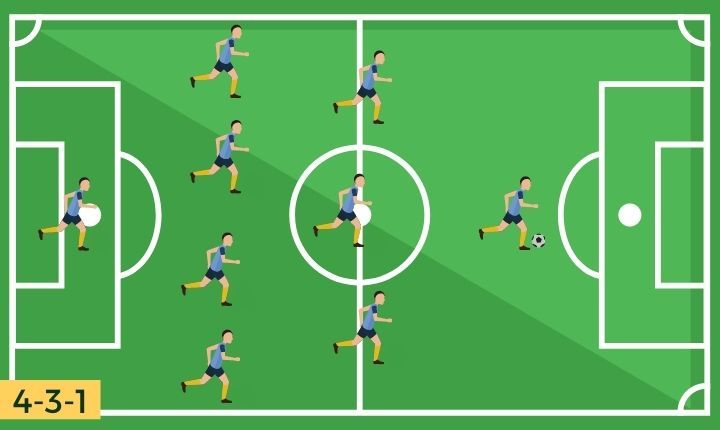
Another more defensive-minded formation is the 4-3-1 which is well worth using if you want to introduce a flat-back four to your players before they make the step up to 11v11.
As well as teaching the four defenders what positions to take up and what zones to defend, it also enables the midfielders to experience playing in a three.
While it’s very compact and hard to play against, the 4-3-1 can also turn into a more attacking formation if the two fullbacks push up into midfield and two of the central midfielders move up to support the lone striker in attack.
This then makes it more of a 2-3-3.
Pros:
- The formation is great for the players' development in terms of what it teaches them for the future.
- It’s very solid and hard to break down.
- The team can keep possession and also be more attack-minded depending on the instructions you give them.
Cons:
- The striker can be very isolated if the team doesn't push forward enough.
- The team won't have much width upfront unless the fullbacks push up.
- The formation hands the initiative to the opposition as it’s primarily set up to be defensive.
2-3-3 Formation
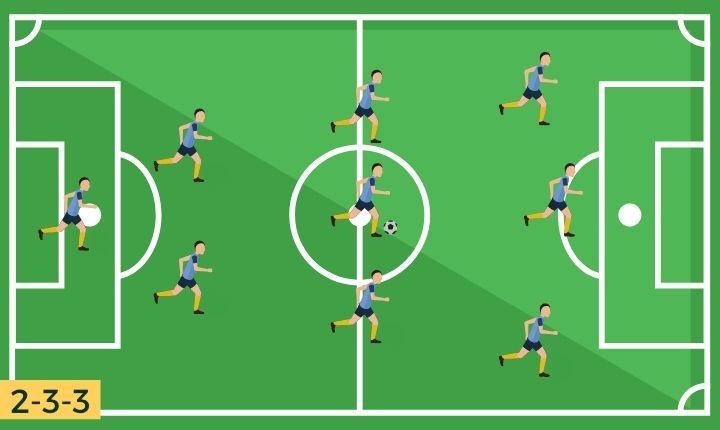
If you want to flip things on their head and go for a much more attacking approach, then the 2-3-3 might just be the formation for you.
One of the most popular 9v9 formations out there, it allows teams to play free-flowing soccer, control possession, and defend from the front.
In addition, it’s very flexible in terms of how you line up with many coaches going for a 2-3-2-1.
As the team is spread around the pitch, it’s a very balanced formation that creates lots of passing angles, width, and depth.
While this allows the team to keep possession, it also ensures that no player is ever too far from the ball, and this helps when it comes to defending and winning it back from the opposition.
Pros:
- The 2-3-3 is very balanced and spread out which helps the team control possession.
- The formation can be used in a number of different ways whether you want to control possession through the centre, counter-attack at speed, or attack down the wings and get crosses into the box.
- While it’s quite attack-minded, the team should be quite solid at the back provided that the forwards track back and help out.
Cons:
- The defenders will have to be very comfortable defending one-on-one situations.
- It relies on the midfielders being hard-working, disciplined, and tracking back from time to time.
- If the team plays with two attacking midfielders rather than wide forwards, the formation can be a bit narrow if the two fullbacks don't push wide.
2-4-2 Formation
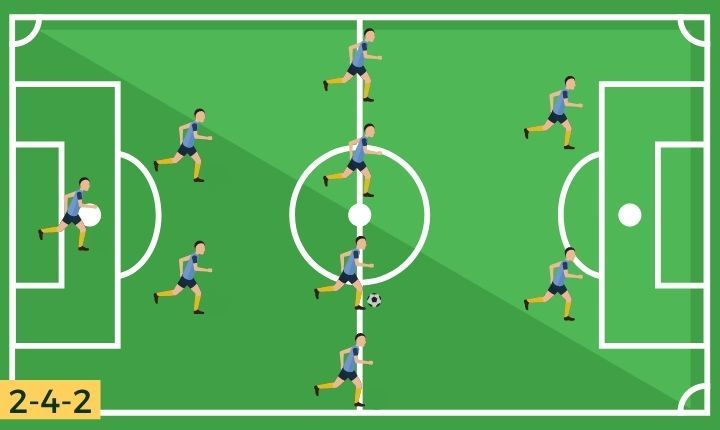
Another popular formation that’s very balanced, structured, and helps teams keep possession is the 2-4-2.
Besides being a very solid line up that almost guarantees control of the midfield, this formation is very valuable in terms of teaching young centrebacks and strikers how to work in a partnership.
This also applies to the four midfielders and prepares them for moving onto the standard 4-4-2 on an 11-aside pitch.
In addition, it also has a great deal of flexibility to it depending on the players you select in the middle and the instructions you give them.
For instance, one central midfielder could be more defensive-minded with the other attacking or both of them could sit and allow the wide players to attack with abandon.
Pros:
- With so many midfielders, you’re almost certain to win the battle in the middle of the park.
- The formation is great for teaching players how to work in partnerships and preparing them for the step up to a full-sized pitch.
- Teams can control possession with all of the depth, width, and passing angles that this formation creates.
Cons:
- The two defenders need to be great at defending one-on-one situations.
- The opposition can exploit the spaces left to the side of either centreback if a defensive midfielder or wide midfielder doesn't cover or track back.
- As the midfielders are required to both attack and defend, they have to be tactically sound and know when to push up and when to drop back.
2-1-3-1-1 Formation
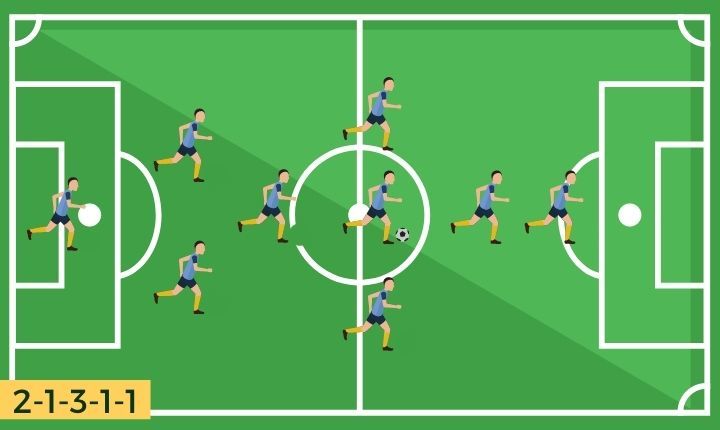
An interesting alternative to the 2-4-2 is the 2-1-3-1-1 which again has a very strong spine to it.
With this formation, the forward players can attack with more freedom thanks to the specialised defensive midfielder who can cover for them.
The attacking midfielder behind the striker is also afforded a lot of freedom in terms of what positions they take up.
While the packed midfield and central areas make it hard to play through, teams using this formation could be vulnerable on the flanks, particularly if the wide midfielders don't track back.
Pros:
- The team has a strong core to it and is hard to play through.
- As the attacking midfielder is allowed to drift, this makes them very hard to pick up and they can create lots of passing triangles or help outnumber the opposition in different areas of the pitch.
- The attacking players are allowed quite a lot of flexibility and freedom thanks to the dedicated holding player.
Cons:
- The formation can be a bit narrow and vulnerable on the flanks.
- Both the defensive midfielder and wide players need to be very disciplined and hard-working if it’s going to work.
- The striker can get isolated if the attacking midfielder keeps dropping back into space or out to the flanks.
Conclusion
As you can see, there are absolutely loads of different 9v9 soccer formations out there that fit every team, situation, and opponent.
While some are more attack-minded, others are very strong and stable at the back with yet others still being perfect for controlling possession and dominating the play.
As playing 9v9 represents a key step on the way to playing full-sized matches, it’s sometimes well worth persisting with a formation even if it’s a struggle due to the important lessons it highlights to the team.
This could help strike partnerships to flourish, teach defenders how to defend one-on-one situations, and allow midfielders to work on their positioning and tactical knowledge.
With the right personnel, coaching, and patience, any one of these 9v9 soccer formations could be perfect for your team and players.

